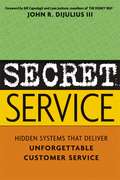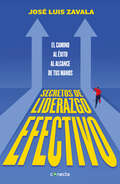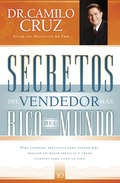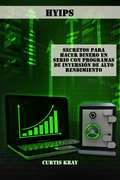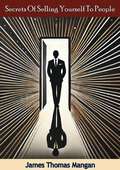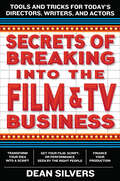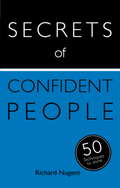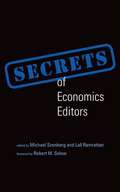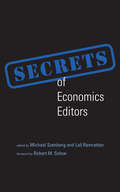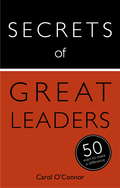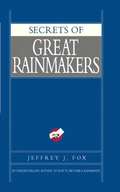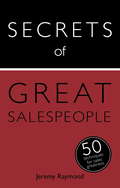- Table View
- List View
Secret Service
by Reg Whitaker Gregory S. Kealey Andrew ParnabySecret Service provides the first comprehensive history of political policing in Canada - from its beginnings in the mid-nineteenth century, through two world wars and the Cold War to the more recent 'war on terror.' This book reveals the extent, focus, and politics of government-sponsored surveillance and intelligence-gathering operations.Drawing on previously classified government records, the authors reveal that for over 150 years, Canada has run spy operations largely hidden from public or parliamentary scrutiny - complete with undercover agents, secret sources, agent provocateurs, coded communications, elaborate files, and all the usual apparatus of deception and betrayal so familiar to fans of spy fiction. As they argue, what makes Canada unique among Western countries is its insistent focus of its surveillance inwards, and usually against Canadian citizens.Secret Service highlights the many tensions that arise when undercover police and their covert methods are deployed too freely in a liberal democratic society. It will prove invaluable to readers attuned to contemporary debates about policing, national security, and civil rights in a post-9/11 world.
Secret Service: Hidden Systems That Deliver Unforgettable Customer Service
by John DiJuliusAll businesses have customers, but how many of them deliver unforgettably good customer service?Customer experience expert and author John R. DiJulius reveals the hidden systems of the few exceptional companies that do: what actions they take behind the scenes to consistently surpass customer expectations. These organizations reap the benefits of greater customer loyalty, exponentially expanded referral networks, lower employee turnover, and stronger bottom-line results.Packed with examples applicable to a wide range of industries, Secret Service provides practical, realistic ways to:Turn customer complaints into positive experiences,Use marketing to go deeper with existing customers,Increase customer and employee retention,and turn bland customer service into truly memorable customer experiences.By quantifying and examining each phase of the "Customer Experience Cycle," Secret Service reveals clever, practical ideas that can be transformed into repeatable best practices in any organization and at every level.
Secret Trades, Porous Borders: Smuggling and States along a Southeast Asian Frontier, 1865-1915
by Eric TagliacozzoOver the course of the half century from 1865 to 1915, the British and Dutch delineated colonial spheres, in the process creating new frontiers. This book analyzes the development of these frontiers in Insular Southeast Asia as well as the accompanying smuggling activities of the opium traders, currency runners, and human traffickers who pierced such newly drawn borders with growing success. The book presents a history of the evolution of this 3000-km frontier, and then inquires into the smuggling of contraband: who smuggled and why, what routes were favored, and how effectively the British and Dutch were able to enforce their economic, moral, and political will. Examining the history of states and smugglers playing off one another within a hidden but powerful economy of forbidden cargoes, the book also offers new insights into the modern political economies of Southeast Asia.
Secret Weapon: How Economic Terrorism Brought Down the U.S. Stock Market and Why It can Happen Again
by Kevin D. FreemanWho's really to blame for America's catastrophic financial meltdown and devastating national recession? Contrary to what the "Occupy Movement" might tell you, it's not just greedy Wall Street executives (though they certainly earned their share of scorn). It's not just failed regulation (even though Washington has failed miserably, both Republicans and Democrats, to protect us). As one of America's top financial professionals reveals in this shocking new book, the failures of Wall Street and Washington have opened us up to economic warfare, with our foreign enemies exploiting our lurking financial weaknesses.In Secret Weapon, Kevin D. Freeman unveils how all the evidence-including motive, means, and opportunity-points to America's foreign enemies as deliberately pushing our economy over the brink.In this stunning exposé, Freeman reveals:The evidence linking Communist China and Islamic finance to economic warfare against the United StatesWhy initial reports linked the 2008 stock market crash to economic terrorism-and why the Obama administration continues to look the other wayHow the financial attack unfolded-and how the perpetrators tried to cover their tracksWhy you should expect another financial attack even more devastating than the last one-and how you can protect yourself from itIn Secret Weapon you'll learn what our enemies know and what the Obama administration has chosen to ignore-that our financial system is profoundly vulnerable to financial terrorism, and that we are being targeted for further and even more destructive attacks by our enemies, who want to cripple America as the world's leading economy. If you want to protect yourself and protect our country, then you need to read Secret Weapon to understand how we have entered a new age of warfare-an age our enemies want to make the Dark Ages of the United States.
Secretos de Marketing en Internet (Como hacer... #17)
by Owen JonesSecretos de Marketing en Internet Espero que la información le resulte útil y rentable. La información de este libro electrónico es sobre varios aspectos del uso de Internet, en su beneficio está organizada en 17 capítulos de aproximadamente 500 a 600 palabras cada uno. Espero que sea de interés para aquellos que esperan ganar dinero en línea. Como beneficio adicional, le otorgo permiso para usar el contenido en su propio sitio web o en sus propios blogs y boletines, aunque es mejor si los reescribe con sus propias palabras. También puede dividir el libro y revender los artículos. De hecho, el único derecho que no tiene es revender o regalar el libro tal como se le entregó.
Secretos de iniciado para supervisores y managers
by Richard G Lowe Jr Nicolás Toledo¿Qué pasaría si te dijera que la mayoría de lo que las facultades enseñan sobre supervisión y gestión de personal es erróneo y hará tú trabajo más difícil? ¿Te sorprenderías o moverías tu cabeza en señal de aprobación porque es algo que has sentido durante mucho tiempo pero que tenías miedo de hablar en voz alta? Trabajar para un buen manager puede ser una experiencia increíblemente reconfortante ya que ellos entienden como delegar autoridades, responsabilidades y tareas a individuos o grupos. Los managers deficientes asignan tareas, fijan plazos de manera arbitraria, y por si fuera poco, no proveen las herramientas adecuadas para lograr las metas. Para cumplir con estos objetivos impracticables, los miembros del equipo deben trabajar muchas horas, por lo general sin ningún tipo de gratificación adicional (los trabajadores asalariados por lo general no reciben pago de horas extras). Un verdadero manager ejemplar fortalece a las personas para trabajar individualmente, y como grupo para trabajar juntos por el bien común de todos los involucrados. Los plazos se fijan luego de consultarlos con el equipo, se entregan las herramientas necesarias y las autoridades y responsabilidades se delegan apropiadamente. Hay muchos libros sobre gestión de personal, y no voy siquiera a intentar escribir un tomo más para explicar alguna técnica de gestión que esté de moda. Ese no es el propósito de este libro. Mi propósito es enseñarte a ti, el lector, una filosofía de cómo triunfar como manager o supervisor de personal. Puedes ir a la universidad para aprender técnicas sobre cómo gestionar robóticamente un grupo. Muchas personas en los lugares de trabajo hacen justamente eso, y muchos de ellos se vuelven buenos managers. De cualquier manera, el mejor aprendizaje proviene de mentores, cursos cortos, libros y de la escuela del trabajo duro, la experiencia.
Secretos de liderazgo efectivo: El camino al éxito al alcance de todos
by José Luis ZavalaSECRETOS DE UN EMPRESARIO MEXICANO DE TALLA MUNDIAL PARA TRIUNFAR EN LA VIDA Y EN LOS NEGOCIOS José Luis Zavala, presidente del Consejo de Administración de CEMZA, el consorcio especializado en servicios offshore para la industria Oil & Gas y una de las 500 empresas más importantes de México, comparte a sus lectores consejos, herramientas, habilidades y conocimientos que fueron determinantes para impulsar su desarrollo profesional y personal. A lo largo de sus páginas Secretos de liderazgo efectivo reúne las anécdotas de vida que el autor ha experimentado a lo largo de su trayectoria en la consolidación de uno de los grupos empresariales más relevantes del país, desde cómo CEMZA logró ser la primera empresa mexicana en brindar servicios de recuperación de cápsulas aeroespaciales a la NASA hasta cómo ha solucionado conflictos del día adía en la rutina de un empresario mexicano, así como las lecciones que ha aprendido en el camino. Los 200 secretos de Zavala te ayudarán a mejorar actitudes, alcanzar objetivos, tomar riesgos, impulsar el crecimiento, mejorar la organización de tu empresa, desarrollar tu liderazgo, ser el mejor en atención al cliente, combatir la competencia, ser un excelente negociador, vender más, cuidar las finanzas de tu proyecto, solucionar problemas, enfrentar el cambio y motivar a la acción. Una extraordinaria guía de actitudes y habilidades para el camino hacia alcanzar tu misión, para crecer como líder y para llevar tu negocio al éxito. Un libro que podría cambiar tu vida para siempre.
Secretos del vendedor más rico del mundo: Diez consejos prácticos para vender más, prestar un mejor servicio y crear clientes para toda la vida
by Camilo CruzSeamos conscientes o no de ello, todos somos vendedores.El vender no se limita al ofrecimiento de productos, sino que incluye la oferta de servicios, ideas, talentos y oportunidades. En este libro, el doctor Camilo Cruz nos presenta un verdadero cofre de ideas, estrategias y principios que nos ayudarán a agregar persuasión a nuestras presentaciones de negocios. Descubre cuáles son las objeciones más comunes de clientes y prospectos y cómo responder a ellas con empatía y seguridad. En esta extrordianaria obra encontrarás diez consejos prácticos que te ayudarán a comunicar mejor tus ideas, atraer a otras personas a tu negocio y crear clientes y asociados para toda la vida.
Secretos para Hacer Dinero en Serio con Programas de Inversión de Alto Rendimiento (HYIPS)
by Curtis KrayDecidí escribir este libro para poder ayudar a todas esas decenas de miles de pequeños inversionistas que se han integrado a Programas de Inversión de Alto Rendimiento (HYIPs) cada año con la esperanza de hacer dinero suficiente para vivir y que, invariablemente han terminado seriamente devastados. Estoy convencido de que la mayoría de la gente que pierde dinero al invertir en HYIPs, carece de la información fundamental sobre su funcionamiento, sobre quienes integran éste juego, y sobre cuál es su verdadera motivación. Para que todos los procesos intelectuales, actitudes y trampas que se tienen que enfrentar puedan entenderse fácilmente es que he escrito este libro. Con la información que se incluye en él, se podrán aprovechar desde distintos ángulos, ingeniosas oportunidades que pondrán en ventaja al inversionista para generar grandes cantidades de dinero.
Secrets
by T. J. RohlederThe famous billionaire Aristotle Onassis once said, “The secret to business is to know something that none of your competitors knows.” He used that mantra to build his fortune. As soon as I read his quote, I began to use it, too. <P><P> The secrets you are about to read are among the best I’ve used to generate tens of millions of dollars for myself and my clients. Now you can use them to build your fortune. There’s nothing complicated about any of these ideas, however, they really are secrets, because most entrepreneurs and businesspeople don’t know or are not using them to make more money. <P><P> For best results, study these secrets and memorize your favorite ones. Then consider how to use them to make all the money you want, need, and deserve.
Secrets & dreams: Secretos del sueño que Alejandro Zozaya convirtió en un imperio hotelero
by Carlos Velázquez MayoralSi usas zapatos grandes, te crecen los pies. Secrets & Dreams es la historia de Alejandro Zozaya, el mexicano que construyó un imperio hotelero y salvó el turismo nacional en más de una ocasión, escrita a partir de las entrevistas que tuvo con el reconocido periodista especializado en negocios y turismo, Carlos Velázquez Mayoral. 2.7 mil millones de dólares fue la oferta que Hyatt hizo a Zozaya para comprar Apple Leisure Group, el consorcio hotelero que más estadounidenses atrae a México, cuyo éxito recae en la operadora AMResorts y marcas como Secrets y Dreams, bajo el modelo todo incluido de lujo, particularmente efectivo en las crisis y que se ha implementado en destinos de playa en México, el Caribe, Centroamérica y España. Su trayectoria comenzó cuando su familia perdió su casa a causa del terremoto de 1985 y se convirtió en una oportunidad económica durante un viaje de mochilero, cuando descubrió su pasión por la hotelería y los restaurantes, carrera que empezaría de cero en Grupo Posadas, lavando platos y limpiando cuartos en los hoteles que años más tarde terminaría dirigiendo. Alejandro entendió el poder de crear y dirigir la demanda, de desarrollar una plataforma estratégica de negocios y de influir en la economía. De ahí que haya jugado roles protagónicos en las últimas crisis del sector, incluyendo las pandemias por influenza AH1N1 y por covid-19, no sólo como líder de opinión, sino proponiendo estrategias de recuperación y fomentando la colaboración entre los empresarios del sector. En este libro, Alejandro, a través de la pluma de Carlos Velázquez, compartirá estos y otros aprendizajes que sin duda resultarán útiles para los jóvenes emprendedores
Secrets & dreams: The secrets behind Alejandro Zozaya´s hotel empire, wich began as a dream
by Carlos Velázquez MayoralIF YOU WEAR BIG SHOES, YOUR FEET WILL GROW. Secrets & Dreams tells the story of Alejandro Zozaya, a Mexican hotelier that built an empire and saved Mexico’s tourism industry more than once. Carlos Velázquez Mayoral, renowned business and travel journalist, sat down with this amazing businessman, who shared his life story through in-depth interviews. Hyatt offered Zozaya 2.7 billion dollars to acquire Apple Leisure Group, the most visited hotel chain by Americans in Mexico, whose success lies in its operator, AMResorts, and brands such as Secrets and Dreams. Its luxury all-inclusive business model has proven to be resilient during crises and has been implemented in important beach destinations in Mexico, the Caribbean, Central America, and Spain. Alejandro’s story, however, started when his family lost their house in the 1985 earthquake that devasted Mexico City. This caused him to turn a backpacking trip across Europe into an economic opportunity: He started working at Grupo Posadas, where he discovered his passion for the restaurant and hotel industry and worked his way up from dishwasher and housekeeper to top executive. Alejandro understood the power of creating and managing demand, developing a strategic business platform, and influencing the economy. This has propelled him as a key player and opinion leader during the last crises that have affected the industry, including the AH1N1 flu and COVID-19 pandemics, proposing recovery strategies and encouraging collaboration between business owners. In this book, Carlos Velázquez writing brings to life Alejandro’s knowledge and insights, useful to young entrepreneurs everywhere.
Secrets Of Selling Yourself To People
by James Thomas ManganJames Thomas Mangan’s Secrets of Selling Yourself to People is a timeless guide to mastering the art of personal influence and building meaningful connections in both professional and personal settings. Packed with practical advice and actionable strategies, this book is an indispensable resource for anyone looking to improve their communication skills, win trust, and leave a lasting impression.Drawing on his extensive experience in sales and human behavior, Mangan breaks down the principles of self-presentation into clear, easy-to-follow steps. From cultivating confidence and charm to understanding the needs and motivations of others, he provides readers with the tools they need to become more persuasive and effective in any interaction.The book covers a wide range of topics, including:How to project a positive and memorable image.Techniques for effective listening and engaging conversations.Strategies for overcoming objections and building rapport.The psychology behind why people say "yes" and how to inspire trust.With its straightforward language and relatable examples, Secrets of Selling Yourself to People transcends its origins as a sales guide, offering valuable lessons for anyone looking to enhance their interpersonal skills. Whether you’re navigating the workplace, networking, or simply aiming to connect better with others, Mangan’s insights remain as relevant today as when they were first written.This book is perfect for professionals, entrepreneurs, and anyone seeking to unlock the secrets of human connection and persuasion. Mangan’s engaging style and practical wisdom make Secrets of Selling Yourself to People a must-read for achieving success through the power of personality.
Secrets d'investissements générateurs de revenus: Recevez des chèques à vie
by Richard Stooker"Rick Stooker est sur la bonne voie. Nous avons également l'intention de poursuivre une stratégie davantage axée sur le revenu dans les années à venir. Les gains en capital sont soumis à la fois au risque d'une baisse des fondamentaux économiques et d'une détérioration de la psychologie du marché. Haute qualité les dividendes et les revenus ne sont soumis qu'aux premiers, et cela fait une grande différence dans la modélisation des rendements de votre portefeuille à la retraite. " - Charles Lewis Sizemore CFA, Analyste principal HS Dent Investment Management, LLC «Je suis comptable agréé au Canada et j'ai passé la majeure partie de ma carrière à enseigner dans un collège communautaire. "Au fil des ans, j'ai utilisé divers" plans ", avec plus ou moins de succès, mais je n'avais jamais beaucoup réfléchi aux dividendes, alors j'ai été la proie du battage médiatique sur les gains en capital. Alors, à quoi pensais-je? J'aurais dû investir pour dividendes. "J'ai également appris l'existence de nouveaux véhicules d'investissement, et j'ai pris connaissance de certains investissements dont j'étais au courant, mais mis en veilleuse. "J'aurais aimé être au courant de tout ça quand j'avais la vingtaine, ou du moins faire attention aux théories impliquées dans la quarantaine." --- Dennis Wilson Alors que les marchés financiers s'effondrent. . .Enfin, vous pouvez également découvrir les secrets d'investissement à l'ancienne - mais désormais révolutionnaires (et mis à jour pour le 21e siècle) - "les œufs d'or" pour les investisseurs paresseux. En dépit de la sagesse financière conventionnelle, de nombreux seniors se demandent maintenant ce qui est advenu du plaisir et de la détente sans souci qu'ils se sont promis après une longue carrière de dur labeur. Beaucoup de gens dans la cinquantaine et au début de la soixantaine se demandent quand - ou même si - ils pourront prendre
Secrets for Thriving in the Gig Zone
by Ketaki KarnikWhat is gig-ing? Will your job be gig-ed out? How do you succeed in the gig world?You think that gig-ing is the future of work? Wrong! The gig era is already here. The gig economy is, arguably, the biggest disrupter of organisational models. Driven by digitisation, remote working, and platform economies, it is transforming the traditional system of employment. More jobs are now being assigned to individual independent contractors. Covid-19 has exponentially accelerated this momentum. Gig is no longer the future; it is now. Whether by choice or perforce, you either are a gig-er or will turn into one very soon.While companies are scrambling to adapt, the impact is most severe at the individual level. Rules of a full-time job do not apply any longer. You will have to reinvent yourself. Thriving in the gig world is not merely about getting your skill set right. It requires mastering four complementary dimensions—Gig Attitude, Gig Lifestyle, Gig Personality, and Gig Functional Skills.Secrets for Thriving in the Gig Zone offers practical hacks to win in this booming world. Based on the author&’s first-hand experiences, this book lays out actionable secrets. Peppered with real-life examples, quotes from other gig-ers, and ready-to-use templates for self-evaluation, this book will steer you to success.
Secrets for Travel Survival: Overcoming the Obstacles to Achieve Practical Travel Fun
by Eugene R. EhmannLeave the stress and anxiety behind, and learn to enjoy traveling again with these expert tips. Travel can be an adventure, but it can also be overwhelming. Written by an experienced world traveler who also entertainingly recounts his own journeys, this guide can help you feel relaxed and ready to go, whether you&’re on the road for business or pleasure. Learn: * How to prepare for your trip to ensure the results you want * How to plan your trip for the smoothest outcome * How to best move through airport security * How to visit or work in foreign countries where you know little or no local language * How to be and feel safe and secure . . . and still have fun!
Secrets of Breaking into the Film and TV Business: Tools and Tricks for Today's Directors, Writers, and Actors
by Dean SilversA highly successful, award-winning independent producer shares his funny, practical, and innovative approach to breaking into film or television, whether you want to direct, act, write, or produce It doesn't take film school or expensive, high-tech equipment to make a brilliant—and marketable—movie today, says successful maverick producer Dean Silvers. For aspiring filmmakers, it's easier than ever to produce—and sell—their work. Secrets of Breaking into the Film and TV Business is packed with concrete, proven advice to help you follow in the footsteps of today's cinematic giants, many of whom broke out with runaway independent successes. Drawing from his own experience as a filmmaker, Silvers offers essential tips and a wealth of invaluable knowledge about every aspect of the moviemaking business, from Internet shorts to how to adapt, option, and collaborate on feature-length films (with shoestring budgets).
Secrets of Confident People: 50 Techniques to Shine (Secrets of Success series #1)
by Richard NugentWhat do confident people know that the rest of us don't?Do they have a secret recipe for success and visibly high self-esteem?Is there a special alchemy at work?'The Secrets of Confident People' reveals the 50 things you need to know to develop innate confidence and improved self-esteem, maintaining your poise and control whatever the circumstances. Some will surprise you, and all will inspire you. Put these 50 simple strategies together and you have a recipe for success, a proven formula that will unlock the secrets and uncover your potential.
Secrets of Economics Editors
by Michael Szenberg Lall Ramrattan Robert M. SolowEditors of academic journals are often the top scholars in their fields. They are charged with managing the flow of hundreds of manuscripts each year -- from submission to review to rejection or acceptance -- all while continuing their own scholarly pursuits. Tenure decisions often turn on who has published what in which journals, but editors can accept only a fraction of the papers submitted. In this book, past and present editors of economics journals discuss navigating the world of academic journals. Their contributions offer essential reading for anyone who has ever submitted a paper, served as a referee or associate editor, edited a journal -- or read an article and wondered why it was published. The editors describe their experiences at journals that range from the American Economic Review to the Journal of Sports Economics. The issues they examine include late referee reports, slow resubmission of manuscripts, and plagiarism -- as well as the difficulties of "herding cats" and the benefits of husband-wife editorial partnerships. They consider the role of the editor, as gatekeeper or developer of content; and they advise authors to write more carefully and clearly, to include citations that locate their articles in the context of the existing literature, and to update their work after it has been submitted and rejected elsewhere. The chapters also offer a timely, insider's perspective on the general effectiveness of the system of academic journals in economics. ContributorsRichard V. Adkisson, Richard G. Anderson, William A. Barnett, Suzanne R. Becker, William R. Becker, Daniel W. Bromley, William G. Dewald, Antony W. Dnes, Zvi Eckstein, Richard Friberg, Esther Gal-Or, Craufurd Goodwin, Thorvaldur Gylfason, Campbell R. Harvey, Geoffrey M. Hodgson, Leo H. Kahane, R. Preston McAfee, John Pencavel, Gerald Pfann, Steven Pressman, Lall B. Ramrattan, J. Barkley Rosser Jr., Paul H. Rubin, William F. Shughart II, Robert M. Solow, Daniel F. Spulber, Michael Szenberg, Timothy Taylor, Abu N.M. Wahid, Michael Watts, Lawrence J. White, Jürgen von Hagen, Fabrizio Zilibotti
Secrets of Economics Editors (The\mit Press Ser.)
by Michael Szenberg Lall RamrattanExperienced economics editors discuss navigating the world of scholarly journals, with details on submission, reviews, acceptance, rejection, and editorial policy.Editors of academic journals are often the top scholars in their fields. They are charged with managing the flow of hundreds of manuscripts each year—from submission to review to rejection or acceptance—all while continuing their own scholarly pursuits. Tenure decisions often turn on who has published what in which journals, but editors can accept only a fraction of the papers submitted. In this book, past and present editors of economics journals discuss navigating the world of academic journals. Their contributions offer essential reading for anyone who has ever submitted a paper, served as a referee or associate editor, edited a journal—or read an article and wondered why it was published.The editors describe their experiences at journals that range from the American Economic Review to the Journal of Sports Economics. The issues they examine include late referee reports, slow resubmission of manuscripts, and plagiarism—as well as the difficulties of “herding cats” and the benefits of husband-wife editorial partnerships. They consider the role of the editor, as gatekeeper or developer of content; and they advise authors to write more carefully and clearly, to include citations that locate their articles in the context of the existing literature, and to update their work after it has been submitted and rejected elsewhere. The chapters also offer a timely, insider's perspective on the general effectiveness of the system of academic journals in economics. ContributorsRichard V. Adkisson, Richard G. Anderson, William A. Barnett, Suzanne R. Becker, William R. Becker, Daniel W. Bromley, William G. Dewald, Antony W. Dnes, Zvi Eckstein, Richard Friberg, Esther Gal-Or, Craufurd Goodwin, Thorvaldur Gylfason, Campbell R. Harvey, Geoffrey M. Hodgson, Leo H. Kahane, R. Preston McAfee, John Pencavel, Gerald Pfann, Steven Pressman, Lall B. Ramrattan, J. Barkley Rosser Jr., Paul H. Rubin, William F. Shughart II, Robert M. Solow, Daniel F. Spulber, Michael Szenberg, Timothy Taylor, Abu N.M. Wahid, Michael Watts, Lawrence J. White, Jürgen von Hagen, Fabrizio Zilibotti
Secrets of Great Leaders: 50 Ways to Make a Difference
by Carol O'ConnorDiscover the 50 secrets that great leaders know - complete with strategies for putting them into practice.What do great leaders know that the rest of us don't? Do they have a secret recipe for success? Is there a special alchemy to leading people? The Secrets of Great Leaders reveals the 50 things you need to know to motivate and inspire those around you. Each chapter outlines one of the 50 ideas and gives three strategies for putting it into practice. Some of the ideas will surprise you, all will inspire you. Put these simple strategies together and you have a recipe for professional success, a formula that will unlock your leadership potential.Whether you want to motivate your team, master public speaking or establish guiding principles and set priorities, this book provides the tools and techniques you need to be a great leader. With nuggets of wisdom gathered over years of experience, for every type of leadership situation, it gives you everything you need to know.
Secrets of Great Leaders: 50 Ways to Make a Difference
by Carol O'ConnorWHAT ARE THE 50 SECRETS OF GREAT LEADERS THAT THE REST OF US SHOULD KNOW?The Secrets of Great Leaders reveals the 50 things you need to know to motivate and inspire those around you. Every one of the 50 secrets in this book contains 3 strategies you can put into practice right now. Some of the ideas will surprise you, all will inspire you. Put these simple strategies together and you have a recipe for professional success, a formula that will unlock your leadership potential.WHAT DO GREAT LEADERS KNOW THAT THE REST OF US DON'T?Do they have a secret recipe for success? Is there a special alchemy to leading people? Whether you want to motivate your team, master public speaking or establish guiding principles and set priorities, this book provides the tools and techniques you need. With nuggets of wisdom gathered over years of experience, for every type of leadership situation, it gives you everything you need to know.THESE ARE THE REAL LEADERSHIP TIPS YOU NEED TO GET AHEADABOUT THE SERIES Some books promise a lot but fail to deliver as they are hard to use in your daily life. The Secrets series boils down the essentials into short, quick lessons - expert advice on a wide range of challenges that's easy to apply. Every secret contains three strategies that make it simple to put them into action on a regular basis. Whether you want to improve your efficiency, clear your desk, or be on top of your work, these books provide the key secrets you need.
Secrets of Great Rainmakers: The Keys to Success and Wealth
by Jeffrey J. FoxIn Secrets of Great Rainmakers, you'll learn how to outsmart the competition and set yourself apart from the pack. In over 50 interviews with industry leaders from a wide variety of fields, bestselling author Jeffrey J. Fox will share the proven techniques and hard-won wisdom that have helped great rainmakers get ahead, along with his trademark brand of counterintuitive insight and commentary that have made his books so popular.
Secrets of Great Salespeople: 50 Ways to Sell Business-To-Business
by Jeremy RaymondDiscover the 50 secrets that great salespeople know - complete with strategies for putting them into practice.What do great salespeople know that the rest of us don't? Do they have a secret recipe for success? Is there a special alchemy to selling? The Secrets of Great Salespeople reveals the 50 things you need to know to in order to sell. Each chapter outlines one of the 50 ideas and gives three strategies for putting it into practice. Some ideas will surprise you, all will inspire you. Put these simple strategies together and you have a recipe for sales success, a formula that will unlock your selling potential. Whether you want to build lasting and profitable customer relationships, hunt down new clients, or are just beginning to work in a sales-related field, this book provides the tools and techniques you need to sell more. With dedicated sections on being a 'Farmer' or a 'Hunter', on customers and for novices, it gives you everything you need to know.
Secrets of Great Salespeople: 50 Ways to Sell Business-To-Business
by Jeremy RaymondDiscover the 50 secrets that great salespeople know - complete with strategies for putting them into practice.What do great salespeople know that the rest of us don't? Do they have a secret recipe for success? Is there a special alchemy to selling? The Secrets of Great Salespeople reveals the 50 things you need to know to in order to sell. Each chapter outlines one of the 50 ideas and gives three strategies for putting it into practice. Some ideas will surprise you, all will inspire you. Put these simple strategies together and you have a recipe for sales success, a formula that will unlock your selling potential. Whether you want to build lasting and profitable customer relationships, hunt down new clients, or are just beginning to work in a sales-related field, this book provides the tools and techniques you need to sell more. With dedicated sections on being a 'Farmer' or a 'Hunter', on customers and for novices, it gives you everything you need to know.

